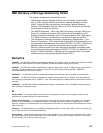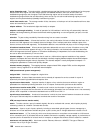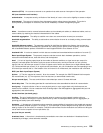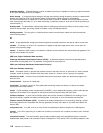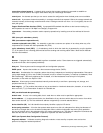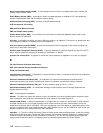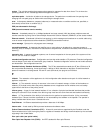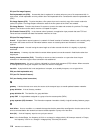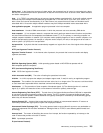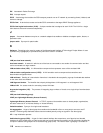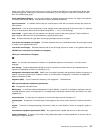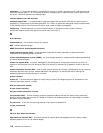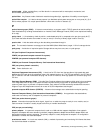direct access storage device (DASD). A mass-storage medium on which a computer stores data. Contrast with
random access memory (RAM).
Direct Memory Access (DMA). A technique in which an adapter bypasses a computer’s CPU, and handles the
transfer of data between itself and the system’s memory directly.
distributed data processing (DDP). Synonym for distributed processing.
DLR (see dynamic link routine).
DMA (see Direct Memory Access).
DNS (see domain name system).
Domain Name System (DNS). In the Internet suite of protocols, the distributed database system used to map
domain names to IP addresses.
drive bay. A receptacle into which you insert a disk drive module in an appliance. The bays are in storage units that
can be physically located in a separate rack from the appliance.
dual inline memory module (DIMM). A small circuit board with memory-integrated circuits containing signal and
power pins on both sides of the board.
Dynamic Host Configuration Protocol (DHCP). A protocol defined by the Internet Engineering Task Force (IETF)
that is used for dynamically assigning IP addresses to computers in a network.
dynamic link routine (DLR). A program or routine that can be loaded by an application or as part of a program.
E
EIA (see Electronic Industries Association).
EISA (see Extended Industry Standard Architecture).
ELAN (see emulated LAN).
electromagnetic interference. A disturbance in the transmission of data on a network resulting from the magnetism
created by a current of electricity.
Electronic Industries Association (EIA). An organization of electronics manufacturers that advances the
technological growth of the industry, represents the views of its members, and develops industry standards.
Electronic Industries Association (EIA) unit. A unit of measure equal to 4.45 cm (1.75 in).
electrostatic discharge (ESD). An undesirable discharge of static electricity that can damage equipment and
degrade electrical circuitry.
EMC. Electromagnetic compatibility.
emulate. To imitate one system with another, primarily by hardware, so that the imitating system accepts the same
data, executes the same programs, and achieves the same results as the imitated system (A).
emulated LAN (ELAN). A specific implementation of a virtual LAN, as it relates to LAN Emulation in ATM networks.
An ELAN consists of one or more LAN Emulation clients (LECs) that share the same LAN Emulation Server and
Broadcast and Unknown Server (LES/BUS). LECs gain membership in an ELAN based on configurable policies. Like
devices on traditional LANs, each ELAN member has a MAC address and can use the LES/BUS to send unicast and
broadcast packets to other members based on MAC addresses.
emulation. (1) The use of a data processing system to imitate another data processing system, so that the imitating
system accepts the same data, executes the same programs, and achieves the same results as the imitated system.
Emulation is usually achieved by means of hardware or firmware (T). (2) The use of programming techniques and
special machine features to permit a computing system to execute programs written for another system.
112 NAS 200 User’s Reference






